All right, class. I know it’s been a while since I’ve taught your section, but I hope that you have taken the opportunity to practice what we talked about last time.
Who here remembers what we talked about before? Yes, you in the second row.
That’s right: how to select your first pipe. Now, how many of you have that pipe with you? Good! I see a lot of briars and corncobs. Oh, there are even a couple of meerschaum pipes in the class. Very well done.
When we last met, I was about to discuss how to select your first tobacco. Let’s talk a little about that now.
Bear in mind, this is how to select your first couple of blends, not how to select a tobacco once you’ve gotten the hang of pipe smoking. By that time, you will have ideally figured out what you like and how to select a new blend to try.
For now, let’s worry about how to select those all-important first blends.
I am not going to tell you the one option that you must do, because I don’t believe there is one, but rather show you your options, with their positive and negative aspects, and then you can make your own, educated decision.
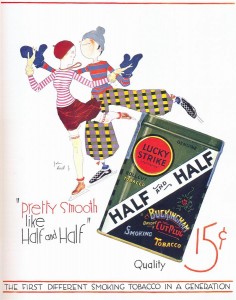 A lot of people out there recommend starting with so-called drug-store blends, such as Half & Half, Prince Albert, and Captain Black. These blends are all extremely popular and are enjoyed by many and smoked exclusively by some.
A lot of people out there recommend starting with so-called drug-store blends, such as Half & Half, Prince Albert, and Captain Black. These blends are all extremely popular and are enjoyed by many and smoked exclusively by some.
There are two principle components within your classic drug-store blend: Burley and Cavendish, typically black Cavendish.
Burley is a common blending component within other types of blends, used frequently to add a little depth and a lot of nicotine. This is a slow-burning tobacco with a mild flavor and a slightly aromatic room-note.
There are many benefits to starting with a Burley-based blend. The flavor will typically be mild and those around you often have nothing but positive things to say about the aroma. In fact, these Burley-based blends will remind a lot of people of “exactly what my grandfather smoked”, which is a line you will hear over and over again.
With these benefits in mind, there are a few downsides. First, it has an extremely high nicotine content, so much so that many experienced pipe smokers still find the “Nic Hit” to be too much to handle. Additionally, the slow-burning quality of Burley means it is prone to bite those who try to smoke too quickly. As new pipesters tend to smoke faster than they really should, they are likely to experience tongue-bite, which very well might turn someone off of pipe smoking.
If you do want to start with Burley blends, I suggest Boswell’s Premium Burley.
Next we come to Cavendish, the primary component of blends like Captain Black.
For clarification, Cavendish is a method of preparation of tobacco, not a particular genus. The tobacco is pressed and then heated, so that it can ferment and become sweet.
Cavendish is very similar to Burley in its benefits. It smells great to passers-by and has a sweet, yet mild, flavor. It also does not have the same amount of a Nic Hit as Burley.
It still has its downside. Cavendish, particularly black Cavendish, tends to be moist, which means that it can be difficult to keep lit if not properly dried and packed. Also, it has the potential of biting, a big downside for any beginner.
 So that no one is confused, when someone says that a blend bites, that person is referring to the sensation known as tongue bite. This is when it feels like your tongue is burning while you are smoking your pipe, or sometimes slightly afterwards. There are two different forms of tongue bite, but both feel unpleasant. The most common is a result of the smoking being too hot, either because of smoking quickly, packing method, or having the tobacco too moist. The other type is a result of the pH of one’s mouth in relation to that of the tobacco. This aspect of tongue bite is a chemical burn rather than a burn resulting from heat. One of the downsides of the chemical variety is that it is different for everyone, since not everyone has the exact same pH levels on one’s tongue and palate, which means a tobacco that causes no problems for one person might bite like rabid dog who didn’t get his morning Kibbles and Bits, no matter how carefully you smoke. Without going too much further into this right now, there are two easy things to avoid while smoking if you find yourself getting frequent tongue bite: alcohol and heavily carbonated beverages (rum and coke will get you both ways!). Both alcohol and carbonation tend to wear down the mucus and membranes that act as a protective coating for your tongue.
So that no one is confused, when someone says that a blend bites, that person is referring to the sensation known as tongue bite. This is when it feels like your tongue is burning while you are smoking your pipe, or sometimes slightly afterwards. There are two different forms of tongue bite, but both feel unpleasant. The most common is a result of the smoking being too hot, either because of smoking quickly, packing method, or having the tobacco too moist. The other type is a result of the pH of one’s mouth in relation to that of the tobacco. This aspect of tongue bite is a chemical burn rather than a burn resulting from heat. One of the downsides of the chemical variety is that it is different for everyone, since not everyone has the exact same pH levels on one’s tongue and palate, which means a tobacco that causes no problems for one person might bite like rabid dog who didn’t get his morning Kibbles and Bits, no matter how carefully you smoke. Without going too much further into this right now, there are two easy things to avoid while smoking if you find yourself getting frequent tongue bite: alcohol and heavily carbonated beverages (rum and coke will get you both ways!). Both alcohol and carbonation tend to wear down the mucus and membranes that act as a protective coating for your tongue.
Anyway, back to tobacco!
Another common starting point is the stronger aromatics. These, too, can often be found at drug-stores and are often flavored with cherry, chocolate, or some other intense sweetener.
Here is where I am going to make my strongest recommendation to you, class. Avoid these for your first blend.
A lot of people assume that aromatics are perfect starting points because they smell sweet and taste a little like candy, at least some do.
That’s great and all, but the downsides so heavily outweigh the benefit that it truly isn’t worth it. First of all, aromatics tend to be a lot wetter as a result of the added syrups, which means that it will take a lot more lights to get the tobacco burning properly. This can lead to intense frustration, scorching the bowl of your pipe, and some serious tongue bite.
Aromatics also encourage people to smoke quickly, since they taste so sweet, which means your tongue will get burned. Bad news bears.
There is a common expression amongst pipe smokers: the better it smells, the worse it tastes. While this is not entirely true in my experience, it has its validity. I tried a blend that smelled just like chocolate and tasted like Pepe le Pew’s aftershave.

Finally, those cheaper and stronger aromatics will leave a serious ghost in your pipe. Ghosting is a pipe term for flavor left over in the bowl from a previous smoke. A lot of blends leave a little ghost, but some aromatics will make their presence known for dozens of bowls afterwards.
Please, stay away from those aromatics during your early days. Remember, however, to take everything I say with a grain of salt. Pipe smoking is done to make you happy, and if you won’t be happy without smoking aromatics, then, by all means, smoke them to your heart’s delight!
If you want to go with aromatics, I would suggest Boswell’s Christmas Cookie or Wilke No. 191, as both are delicious but not as heavily cases as some others.
Another option, rarely mentioned, is to start with what are considered the more difficult styles of tobacco: straight Virginias and Englishes.
Virginias are wonderful. They are sweet; they are simple; they are straightforward; they are aromatic in their own right, yet sophisticated.
One caveat, class: avoid flakes. For now, take care to only get ribbon or shag cut Virginias.
Ribbon style tobacco is tobacco that hat been cut into very, very thin strips, normally between 1/16″ and 3/32″ wide, and literally look like little ribbons of delicious flavor. Shag cut tobacco is an even finer version of a ribbon cut (I mean “fine” as in “thin”, not as in “good”).
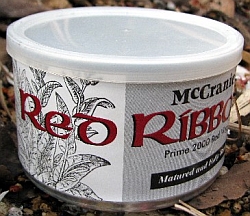 The reason I advocate avoiding plugs, flakes, cakes, plugs, and ropes Virginia at this point is an issue of difficulty. First of all, tobacco in the above forms has to be prepared, something that normally involves cutting, rubbing, slicing and dicing, or some method that is more time consuming than most novices care to do. Additionally, these forms lend themselves to smoking hot and giving a nicotine kick.
The reason I advocate avoiding plugs, flakes, cakes, plugs, and ropes Virginia at this point is an issue of difficulty. First of all, tobacco in the above forms has to be prepared, something that normally involves cutting, rubbing, slicing and dicing, or some method that is more time consuming than most novices care to do. Additionally, these forms lend themselves to smoking hot and giving a nicotine kick.
If you want to go with a Virginia for your first tobacco, I recommend McClelland 5100 or McCranie’s Red Ribbon.
Now come English blends.
Let’s start with the downsides of English blends. Well, isn’t that the damnedest thing? I can’t really think of any!
Okay, fine. I don’t want to sound biased.
Englishes do not have the most pleasant aroma for some people, and the acceptance and encouragement of close friends and family can be a big factor when you first start smoking. Also, the flavors tend to be more complex; it takes more thought, more examination, and a slower pace to fully appreciate the blends. In truth, the complexity and the demand for the smoker to slow down is actually a benefit, once you get down to it.
Once you get past those small issues, Englishes are phenomenal. They tend not to bite as often as other styles, they don’t get boring as quickly, since their flavors continue to change as your taste-buds evolve, and they are perfect for around campfires.
You can probably tell where my bias lies and what I would suggest starting with. It is not the most conventional piece of wisdom to recommend starting with Englishes, as they are often thought of as one of the two most advanced style of tobacco. Recently, however, this suggestion appears to be picking up steam.
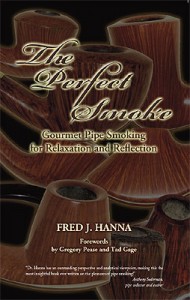 I have been slowly working my way through Fred Hanna’s new book, The Perfect Smoke: Gourmet Pipe Smoking for Relaxation and Reflection, and I am enjoying it immensely. In one of the earliest essays in the collection, Hanna addresses the issue of what tobacco to start with and says that a lot of people make the mistake of recommending a mild burley or Virginia based aromatic for beginners. The problem with this, he contends, is that a newer pipe smoker is not as able to detect and appreciate the mild and subtle flavors and will thus do one of two things: A) Determine pipe smoke is flavorless and give up, or B) Puff furiously to get more flavor, burn his tongue, and give up. The result is the same either way.
I have been slowly working my way through Fred Hanna’s new book, The Perfect Smoke: Gourmet Pipe Smoking for Relaxation and Reflection, and I am enjoying it immensely. In one of the earliest essays in the collection, Hanna addresses the issue of what tobacco to start with and says that a lot of people make the mistake of recommending a mild burley or Virginia based aromatic for beginners. The problem with this, he contends, is that a newer pipe smoker is not as able to detect and appreciate the mild and subtle flavors and will thus do one of two things: A) Determine pipe smoke is flavorless and give up, or B) Puff furiously to get more flavor, burn his tongue, and give up. The result is the same either way.
So, Hanna contends, and I fully agree, why start with something mild in flavor when you are engaging in an experience aimed explicitly at eliciting enjoyable flavors?
Just for clarity, I am not citing Mr. Hanna as an appeal to authority, but rather as evidence that this approach that I have recommended for a while, without knowing that it was embraced by Fred Hanna, as well, is gaining in popularity.
After this little rant, the question remains: what is the verdict with Englishes? I say to go for it! If you start learning to appreciate the complex blends early, then you will be able to be a far more discerning pipe smoker. I would suggest McClelland’s Old Dog and Blue Mountain along with G.L. Pease’s Westminster. All three are stellar blends that will treat you well!
Once again, though, I return to my familiar mantra: do what makes you happy.
Even if all of my advice were perfect, which I’m sure it isn’t, it still comes down to personal preference. I cannot tell you which tobacco you will and must enjoy, all I can do is give you as much knowledge as possible for when you start your journey. You have my suggestions, now enjoy your pipe!
That’s your homework for today. Enjoy your pipe. Maybe write down a couple of notes about what you taste in your tobacco, what you experience.
Are they any questions, class?
Yes, you.
Ah, great question: accessories for pipes.
BRRRIIIIIIIIIINNG!
Oh, we’re out of time! I guess I’m more long winded than I thought. Accessories will have to wait for next time!
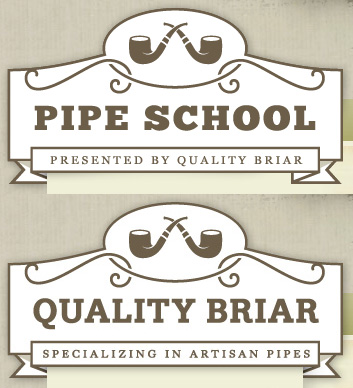
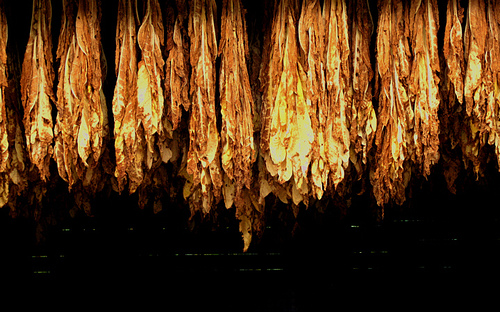

 Subscribe to RSS feed
Subscribe to RSS feed
Great advice. Perhaps you would like to explain to the readers what brands you call English? Giving them something to go out and buy.Brand names.
Very good point, Alan! How silly of me not to include those…
Hello Ethan,
you have a fantastic blog over here; just followed the link in your comment and found the pot of gold the the end of the rainbow. Thank you very much for you hard work on writing these articles, I will recommend you blog whenever I can
And I, too, agree that a beginner should start with Englishes – there are surely more decent English mixtures on the market than aromatics, and they present the ‘real’ tobacco flavors much more honestly than cased tobaccos.
Happy puffing!
Cheers,
Julius